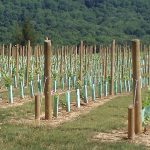Grow your own: backyard vineyard
Planting a backyard vineyard can be a daunting task and depending on how much work you want to put into it and the size of the vineyard, it’s definitely possible that it will end up taking up a lot more time than you had even anticipated. But – it is so worth it when you get to make wine from the literal fruits of your labor!
Research the below topics in as much detail as possible before planting your backyard vineyard. You will be making a lot of decisions and each decision you make will affect all other decisions that follow. Have a solid answer to the following questions:
- What is the soil type? Are there nutrient deficiencies (or excesses?) Climate and micro-climate of the chosen location? Slope and direction the vines will be planted in? Will you need to amend the soil at all and if so, how?
- What grapes will grow best in these conditions? (And are these varieties you even have an interest in growing?
- How will the vines be planted? (Shovel, post hole digger, PTO-driven tractor mounted post hole digger?)
- Will you plant an inter-row cover crop?
- Is an irrigation system something that is needed?
- Which disease pressures are you most likely to encounter, and what are you open to spraying in order to combat it?
- What trellissing system, inter row spacing, and between vine spacing are you interested in doing?
- Work hard to get your shoot (which will become the trunk) as straight as possible. This isn’t just about aesthetics, it’s about practicality. Regardless of whether you’ll be going through the rows with a tractor, you’ll still likely be going through with a mower; having trunks that lean out into the row can be a disaster waiting to happen. Consider using metal rods as opposed to bamboo shoots – there’s less potential for breakage over the first couple of years.
- If you will be using a tractor, make sure you leave plenty of room in the headlands (the space surrounding the vineyard where you will be turning the tractor around after riding through each row) – without ample space, you’ll find yourself unable to turn into the next row!
- Amend your soils before. It’s impossible to incorporate amendments to the soil post-planting in the same capacity as pre-planting.
- Don’t just plant grapes that will grow – plant grapes that will grow AND that you care about! You’ll be a lot more excited about caring for your Cayuga grapes if you enjoy making Cayuga wine, as opposed to feeling lackluster about your Seyval grapes if you don’t actually enjoy making Seyval wine, as an example.
Despite the fact that vines can always be removed if need be, vineyards in and of themselves are pretty permanent perennial structures. They’re not going anywhere unless they die or you rip them out. So do as solid a job as possible when you are putting in the initial work. Trying to fix mistakes made in the creation of the vineyard after the fact are so much more difficult to navigate as opposed to putting in that little bit of extra work at the onset and doing it right.
Look over the questions posed above, be certain you have solid answers and reasoning behind each one, and you’re well on your way to having your very own homemade wine, from vine to bottle. Cheers and happy planning and planting!
The Importance of Pruning Your Home Vineyard
After a holiday respite, when the thermostat plunges downward, comes every grape growers’ favorite task: winter pruning of the vines. This arduous process is integral to the health of the grapevine and its next vintage.
When:
- In late winter to early spring (February-April). In this dormant period, the sap and water runs down from the cordons of the plant into the trunk and roots, allowing the plant to winterize. This cold hardiness will improve over time and the life of the plant. Once the plant has endured the freezing temperatures of the winter, it will be ready to prune.
Why:
- Any grower who has attempted to work with grapes, knows that they are incredibly hardy and vigorous plants. Without aggressive winter pruning, removing approximately 90% of the previous years’ growth, the grapevines will continue to grow vigorously and become and entangled mess upon the trellis. All of the added weight can break the trellis and will generate too much foliage to allow the grapes to receive proper sunlight. The extra foliage can also allow diseases to carry over from the prior growing year, giving them an early head start as soon as temperatures rise.
How:
- There are two main methods of grapevine pruning: cane pruning and spur pruning. In cane pruning, the grower will select the two or four most inner canes closest to the trunk and keep those as renewal canes and remove all of the other growth. On some hybrid or native plants, you could be removing some canes that run 15 feet long! You can’t kill a grapevine, so no need to worry about the large amount of plant material you are removing. It should be about 80-90% of the growth from the former year.








Recent Comments